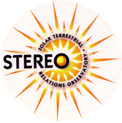Coordinate Systems Descriptions
Transformation matrices for converting vectors from the S/C coordinate system to the coordinate systems listed below are provided by Caltech as text files to the SEP instrument teams.
Spacecraft position data are also provided as text files.
GEI: Geocentric Equatorial Inertial. The X axis points toward the first point of Aries (i.e. the vernal equinox), and the Z axis is aligned with the geographic north pole. When expressed in terms of longitude and latitude, this is the well known celestial coordinate system of right ascension and declination. This is realized with the J2000 ecliptic.
GSE: Geocentric Solar Ecliptic. X is the Earth-Sun line, and Z is aligned with the north pole for the ecliptic of date.
GSM: Geocentric Solar Magnetospheric. X is the Earth-Sun line, and Z is the projection of the north dipole axis.
HCI: Heliocentric Inertial. Z is the solar north rotational axis, and X is the solar ascending node on the J2000 ecliptic.
HEE: Heliocentric Earth Ecliptic. X is the Sun-Earth line, and Z is the north pole for the ecliptic of date.
HEEQ: Heliocentric Earth Equatorial. Z is the solar rotation axis, and X is in the plane containing the Z axis and Earth, at the intersection of the solar central meridian, and the heliographic equator. When converted to longitude and latitude, this is known as Stonyhurst heliographic coordinates. In FITS files, this coordinate system is abbreviated as , so that variation is also recognized by the software.
HGRTN/RTN: Radial-Tangential-Normal. X axis points from Sun center to the spacecraft, and the Y axis is the cross product of the solar rotational axis and X, and lies in the solar equatorial plane (towards the West limb). For the STEREO Ahead spacecraft, this is realized through the dynamic coordinate frame STAHGRTN, while for STEREO Behind it is realized through STBHGRTN. When the Sun is used as the origin, the designation is HGRTN; with the spacecraft as origin, it is simply RTN.
